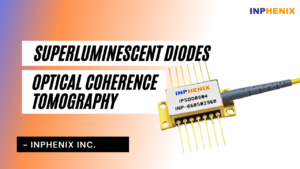
Optical Coherence Tomography (OCT) is a novel clinical technology that is widely used in ophthalmology and other medical fields. The technology provides two and three dimensional, cross-sectional, micron-scale images of biological tissues within optical scattering media.
This technology has been used extensively for imaging tissue microstructure in various medical fields ranging from ophthalmology to gastroenterology. OCT primarily used two types of light sources for the imaging process- a) Femtosecond Lasers or b) Superluminescent Diodes (SLD).
However, the high prices and difficult operation of Femtosecond lasers have throttled its widespread adoption in medical applications. At the same time, it has ultimately paved the way for superluminescent diodes for optical coherence tomography in the clinical industry.
Let us first understand what superluminescent diode is and what OCT is in brief.
Wikipedia defined the superluminescent diode as “A superluminescent diode is an edge-emitting semiconductor light source based on superluminescence.” In simple words, SLD is a semiconductor device that emits low-coherence light but with high brightness. These diodes are ideal for various clinical applications, including Optic Gyroscopes (FOG) and Optical Coherence Tomography (OCT).
Superluminescent diodes for OCT are compact, robust, and easy to operate. Moreover, they are very economical in rates compared to Femtosecond solid-state lasers. The recent research and development in the field of SLD will significantly enhance the clinical applications of UHR-OCT (Ultrahigh-resolution optical coherence tomography) imaging.
As mentioned above, Optical Coherence Tomography (OCT) is a new-age clinical technology that is widely used in ophthalmology among other medical fields. It is used to evaluate and treat the disorders associated with the optic nerve.

The Superluminescent diodes for optical coherence tomography work on the principle, which is very similar to the laser diode principle. The diode becomes active by flowing forward current to the p-n junction and generates amplified emission across a wide range of wavelengths.
Some of the primary characteristics of the superluminescent diodes for optical coherence tomography are as below:
The high power output, large bandwidth, and low spectral ripple make the superluminescent diodes an optimum choice for clinical applications. The use of Superluminescent diodes for optical coherence tomography is very well known. However, along with OCT, SLDs are also used in optical sensing, fibre-optic gyroscopes, and white light interferometry.
Inphenix is a US-based company that primarily deals with superluminescent diodes, swept-source lasers & distributed feedback lasers (DFBs), among other lasers and light sources. The company’s SLDs are well-known in the market for spectral free emission and high power outputs. You can call us or mail us for any inquiries or assistance related to our products or services.
